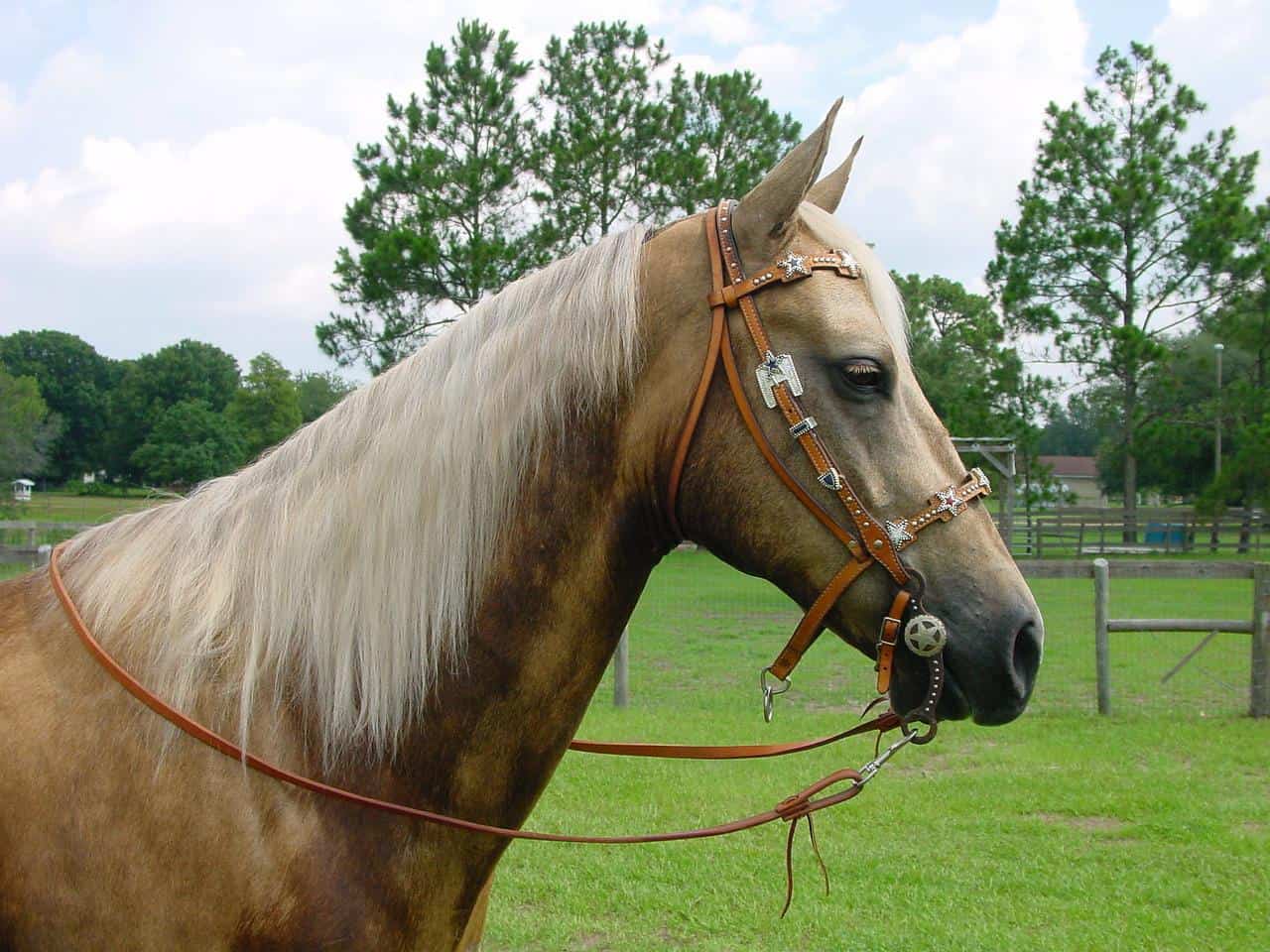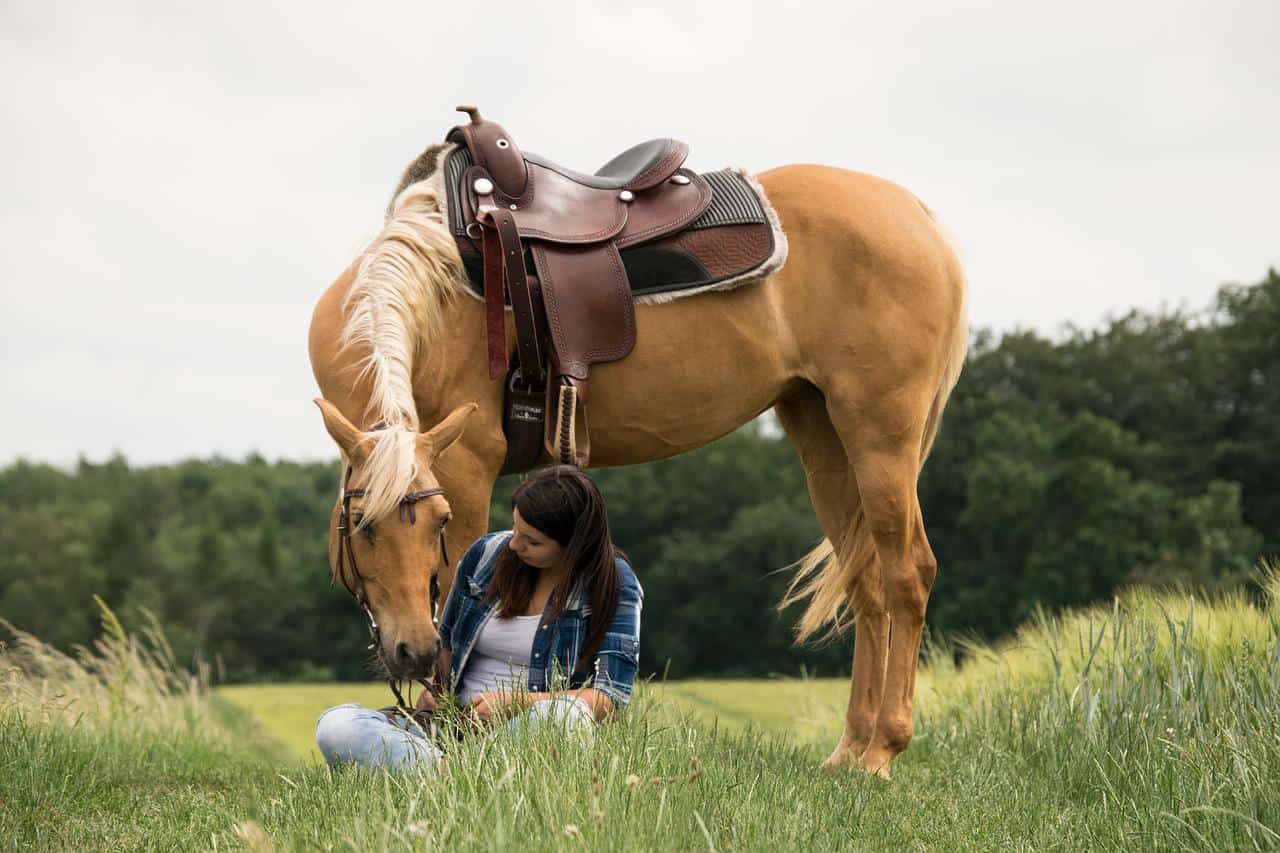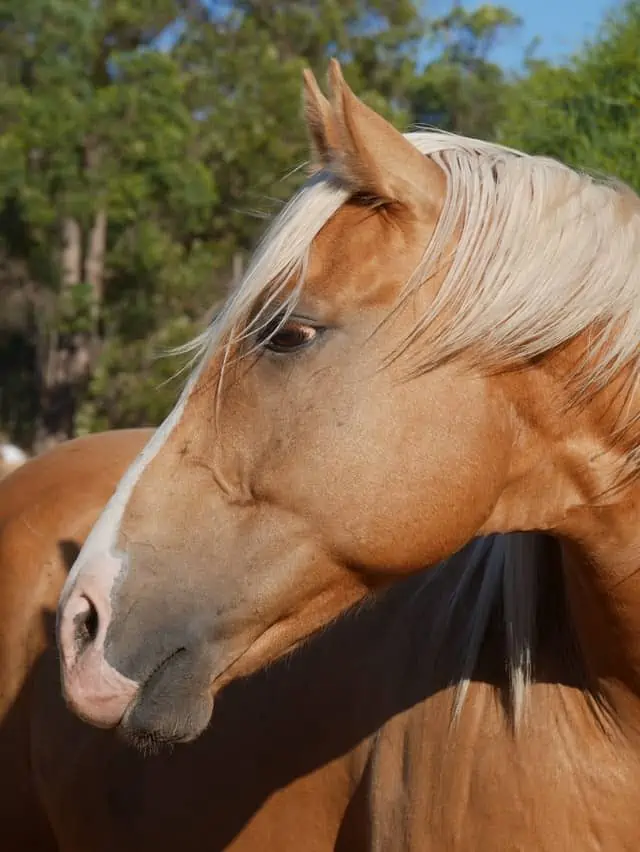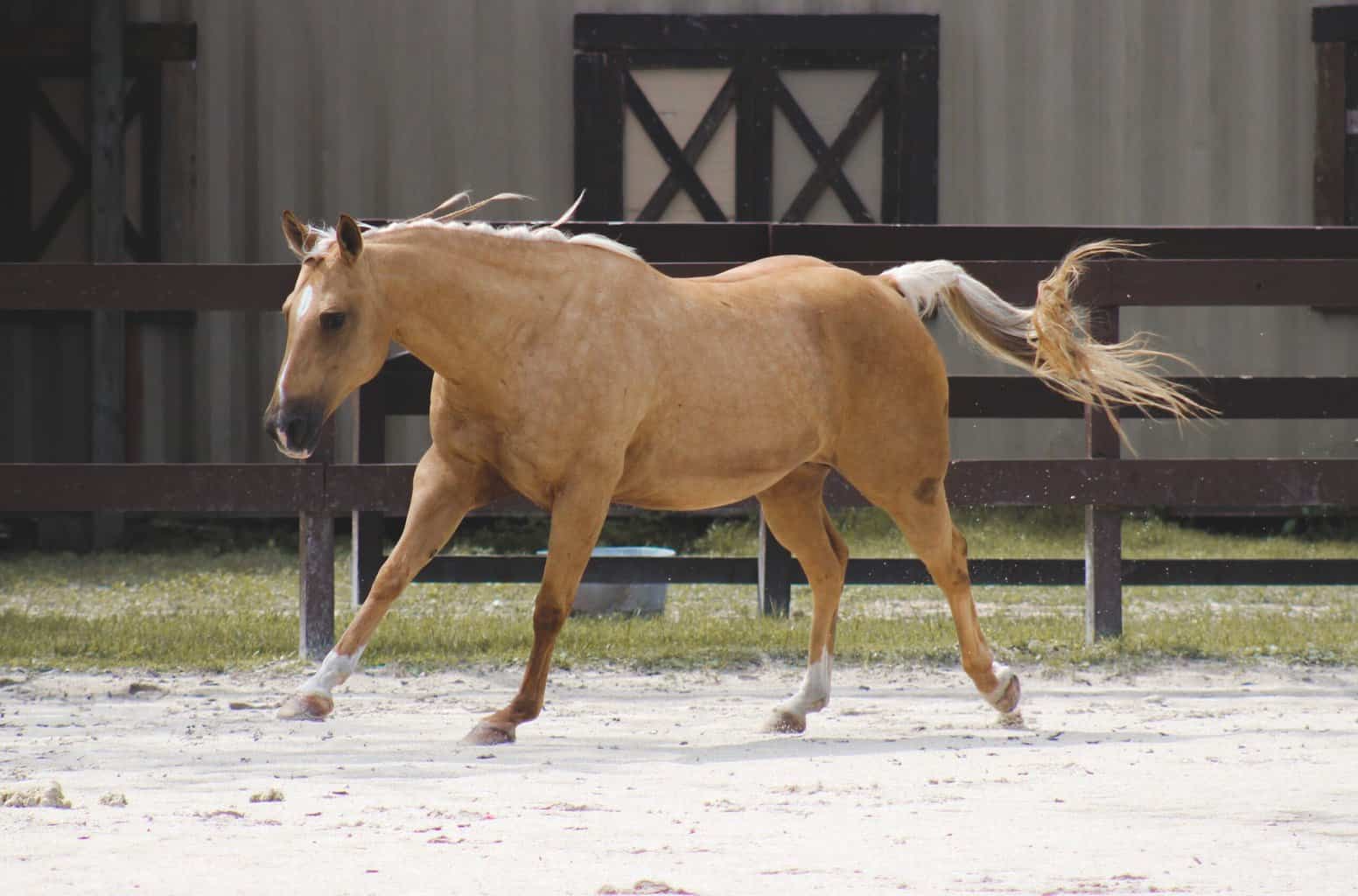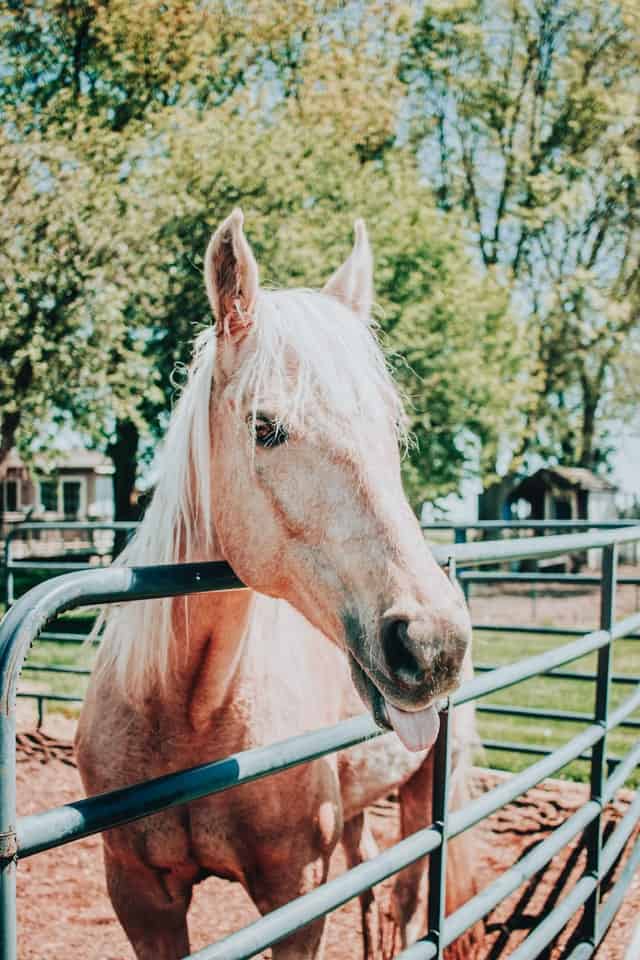- Sorrel Horse Guide - July 5, 2022
- Palomino Horse Guide - May 31, 2022
- Palominos: What Are Their Origins?
- Here Is a List of Breeds That Make Up the Palomino:
- Are Palominos a Rare Horse?
- Palominos Physical Traits
- Are Palominos a Big Type of Horse?
- The Typical Palomino Color Palette
- Breeding Palominos
- Palomino Characteristics
- What Are Palominos Popular for?
- What Is the Palomino's Diet?
- How Much Are Palominos?
- FAQs
- Palomino Horse: A Final Word on Palominos
Like most little girls, I would dream of having a horse to call my best friend. And the Palomino Horse Breed? This is precisely the beautiful kind of horse that my daydreams were made of – after the shiny hue of the Black Beauty story wore off, of course.
Have you ever seen a palomino horse before? You’ve probably seen one in a movie or perhaps in a painting if you have. Most palominos have golden bodies with white manes and tails.
Most people agree that the Palomino horse is not an actual horse breed but rather a color. This means that a specific hair coloration makes a horse look like a Palomino. And despite my romantic notions, I would have to agree. So on that note, Palomino is a color, not a breed. Instead, they result from a genetic mutation that causes their coats to turn from dark brown to light gold.
This characteristic color makes them stand out from other horses, which makes these animals so popular. But many people agree that the Palomino Horse comes from the Appaloosa breed, which is actually a true horse breed. The Appaloosa breed has been known for its distinctive spotted coat since the mid-19th century, when it was first imported from Russia by American ranchers in Oregon and Idaho.
In my opinion, the Palominos are the “blondes,” so if you see a light golden horse with a blonde mane and tail, you’re lucky enough to be looking at a pretty Palomino. So without further ado, let’s dive into the Palomino horse guide!
Palominos: What Are Their Origins?
There are a few different theories about where they came from and why they exist. Still, there is no explicit agreement on any one theory. Will experts ever agree? Probably not. But here are some of the most popular theories (and fun myths!):
Let’s start with some fun myths:
- The first theory is that they were created by an ancient race of people who lived in the mountains of Tibet. They believed that if they sacrificed a horse every year during their spring festival, they would receive good luck for the rest of the year. The sacrifice was called “t’ein tseu,” or “giving thanks.”
- Some people believe that they were created by God himself—a gift to mankind so that we could have a way to travel over great distances in times of need. Others say they were first seen during the Crusades when knights rode into battle on golden horses as they fought against Muslims in Jerusalem.
- Another theory suggests that Chinese monks created the horses during the Tang dynasty (618–907). These monks were known for their ability to create objects out of thin air—including horses! Some people believe these horses were used for transportation and communication between temples and villages at great distances away from each other.
We do know that the Palomino is a Spanish name and is a common surname in Spain as well! The name “palomino” comes from the color of these horses’ coats—a light golden color. The word palomino translates loosely to “pale yellow” in Spanish. This is why you’ll see this breed referred to as “the yellow horse.”
It’s well known that horses have played an important role in human history. The Crusades, for example, would not have been possible without them. But did you know that the palomino horse has also had a hand in these events? Queen Isabella of Spain shipped five mares and a Palomino stallion to her viceroy in Mexico during this period.
The queen had such a fondness for these horses that she wanted to send them to her viceroy so he could breed them and use them as war horses. This is how they arrived on Mexican soil during one of the most critical periods in human history.
The Palomino horses quickly spread throughout Mexico, where they were used for pulling carriages and other heavy loads, but soon became famous for their beauty as well. They eventually spread throughout states like Texas and California, where they can be found in abundance today.
Though there may never be one true answer as to how these horses came into existence, it’s clear that their beauty is undeniable!
Here Is a List of Breeds That Make Up the Palomino:
A strong and refined horse with a beautiful golden coat, the Golden Dorado has been in existence for hundreds of years. However, most of its ancestry is unknown, making it one of the least documented horse breeds in history. Think of the Golden Dorado as the conquerer’s Palomino. So, let’s look at the breeds that make up the Palomino:
- Moorish and Spanish breeds
- Arabic
The Golden Dorado is very similar to the Arabian and Moorish Barb horse breeds. Many horse experts agree that their coloring (if we consider Darwinism) suggests that the Palomino type is descended from the desert, where the light mane, tail, and coat are better protection against the harsh desert heat.
Okay, so now we can deduce that the Palomino could be the descendant of Arabian and Moorish Barb. Overall, I can safely say that the Palomino is a horse made up of Spanish stock. I am swooning over here at the thought of a herd of Spanish horses on a sunkissed hill.
While I genuinely believe that genetics are more mixed (across all breeds) than we care to admit, there is something so regal about Arabian and Moorish horses. And throw in a couple of Apalusian and Palominos, and well, that’s literally the stuff my dreams are made of.
Are Palominos a Rare Horse?
The Palomino is neither rare nor is it common- it’s a happy medium! But don’t make the mistake of thinking that every light brown or golden colored horse is a Palomino. Certain distinct physical traits make a horse a Palomino.
Palominos Physical Traits
The Palomino’s coloring is the trademark that makes a Palomino, well, a Palomino. The most distinctive characteristic of a Palomino horse is its golden coat and white mane and tail.
This color has been passed down through generations of horses. Some horses have darker brown coats, but most have lighter coats. They can have white markings on their legs or faces, but these markings are not considered to be very common in this breed. The Palomino is also typically lean with a solid muscular frame.
Are Palominos a Big Type of Horse?
If you’re looking for a big and bold horse, the Palomino is the perfect choice for you. They are known for their height and personality, so they’ve been used in Western movies and shows for so long.
The Palomino is typically a large horse, and I mean intimidatingly tall. They average between 14 and 17 hands, so yes, they are enormous! Palomino horses typically weigh around 1,250 lb, but they can get up to 2,000 lb under the right conditions.
The Typical Palomino Color Palette
Palomino horses are beautiful animals. They have a glossy golden coat, which is the color of the sun. And while their coloring is usually a light golden hue, there are definitely some differences in the shades and hues. Some Palominos are lighter, and some will have a darker golden brown.
The reason why is simple: Palominos come in many shades of brown! They can range from creamy white all the way up to light brown or even darker shades of brown (which some people call “chestnut”). Some registries even allow Palominos with three shades darker or lighter than the standard color to register as Palominos.
Besides their golden hue, they often have a highly contrasting mane and tail. This contrast is one of the pivotal physical aspects of the Palomino. Many Palominos also have distinctive white markings in the shape of a star or blaze or just a simple snip on their faces.
A Palomino might have white hair on their legs, but the white will never extend beyond the knees. Unlike an Appaloosa, the Palomino will not have white markings on its body. But where does this golden hue come from? The trademark golden hue results from a gene called a ‘creme dilution gene’ or a ‘creme dilute.’
Breeding Palominos
As I mentioned earlier, three breeds could make up the beauty that is the Palomino:
- Spanish
- Arabic
- Moorish
Horse breeders agree on the general consensus that the golden coloring of this horse’s coat is what makes a Palamino a Palamino- and not any gene or anything hereditary.
According to the American Quarter Horse Association (AQHA), three breeds fall under the category of “palomino”: desert palomino, gold palomino, and sorrel palomino. They all share similar characteristics: they have golden coats with white (or cream) manes and tails.
Palomino Characteristics
Whether you are a beginner or an experienced rider, the Palomino should be on your list if you are looking for a horse that will be easy to train and fun to ride. Palominos are known to be the most gentle and loving horse breeds. They are not only beautiful but also intelligent. This is why they are highly sought after as show horses, trail horses, and even as pets.
These horses are known for their calm temperament and versatility, making them ideal for any horse owner or rider. Even if you have minimal experience with horses and limited interaction with them, you will likely have no problem with the Palomino.
But remember, their personalities are generally gentle, but they can be stubborn at times due to their high intelligence level. A common misconception about this breed is that they are all docile and calm animals. However, this is not true for all Palominos because some can be aggressive and even dangerous if trained improperly or mishandled by their owners.
The temperament of an individual horse would also depend on its true breed and other factors such as age, gender, etc. Keep in mind that a Palomino could come from various breeds, which will play a significant role in determining their personalities and temperament. So I strongly advise you to find out the specific horse’s genetic makeup if you want to know more details about the horse’s temperament before buying them.
What Are Palominos Popular for?
Palomino horses are the perfect choice for anyone looking to add a versatile horse to their stable. They’re highly durable and have incredible endurance, so you can use them in just about any type of equestrian activity. Palominos are also known for their maneuverability, making them excellent at jumping, racing, and trail riding.
Palomino horses are easy to care for and easy to train, making them ideal for beginners or anyone who wants a low-maintenance pet. They have a friendly temperament that makes them great companions.
For many years, the Native Americans rode Palominos. They used them for hunting, transportation, and warfare. The Native Americans favored this horse breed because it was easy to train, had a gentle disposition, and was particularly well-suited for war.
They were considered high-status animals—and owning one reflected your wealth and status in society. People used to own these horses to show off their wealth and impress people. Up until recently, owning a Palomino was considered a symbol of power and prestige.
However, today’s Palominos are not just prized for their looks but also because they make excellent riding animals. This is due to their intelligence, beauty, and gentle nature. They are also great with children since they tolerate rough play and can be very patient with them when learning how to ride them properly on their backs!
What Is the Palomino’s Diet?
Like many horses, the Palomino horse should have the following included in its diet:
- grain
- grasses
- hays
- salt
- access to clean, fresh water.
Something to bear in mind:
Palominos are subject to smutting, depending on their diet. Smutting will cause discolorations in the horse’s coat, and these can show up as darker patching on the body. If a horse eats a diet high in protein, its coat could develop these darker variations. And if the diet is rich in iron, you might notice a reddy shade begin to show through their typically creamy tails and mane.
How Much Are Palominos?
It’s important to know that the price you pay for your horse is based on several factors:
- The true breed of the horse (many different kinds can make up a Palomino)
- The horse’s health, strength, and fitness affect how well it can do its job.
- Its skill sets—even if a horse has excellent breeding or training, its value will go down significantly if it’s not comfortable with specific tasks or work environments.
All that being said, the price can vary from $5000 to $30 000, depending on the factors I outlined above.
FAQs
Answer: There isn’t a perfect answer to this question because it would depend on what breeds make up your Palomino that you have in mind. That being said, Palominos are generally accepted as being gentle, calm, and easy to train. But remember, if your Palomino descends from a line of thoroughbreds, then you could have a more excitable and headstrong horse on your hands.
However, experts will generally agree that Palominos primarily descend from Quarter horses. Now, if we assume that to be true for all Palominos, then you can expect your Palomino to have similar calm gentleness in their nature as is true for Quarter horses.
Answer: Diet will significantly affect color variations throughout a Palomino’s lifetime. This is known as smutting. The climate may also play a role as the hotter climates might encourage the Palomino to have a lighter color.
Answer: A typical palomino could live up to 30 years of age- but again, this will depend on what breeds your specific Palomino will come from.
Palomino Horse: A Final Word on Palominos
The Palomino horse is a unique breed that can be found in many different shades of gold and brown. Their coat color can range from pale gold to deep golden brown when it comes to their coat color.
The Palomino is actually one of the most popular types of horses. It was initially bred in Spain, but today many different breeds worldwide have been influenced by this Spanish breed. The Palomino is known for its unique coloring and gentle temperament. It’s also known for being very versatile when it comes to riding and working and being an excellent family pet.


